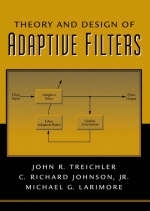
Theory and Design of Adaptive Filters
Pearson (Verlag)
978-0-13-040265-3 (ISBN)
- Titel ist leider vergriffen;
keine Neuauflage - Artikel merken
Designed for graduate level courses in adaptive filtering and to serve as a valuable reference for practicing engineers.
The authors develop the basic rules and algorithms for filter performance and provide tools for design, along with an appreciation of the complexity of behavioral analysis. Derivations and convergence discussions are kept to a basic level. The presentation focuses on a few principles and applies them to a series of motivating examples, that include in-depth discussion of implementation aspects for filter design not found in other texts. Rather than superficially examining an extensive list of possible applications benefiting from adaptive filter use, the authors examine four such problems in detail and review the common attributes that are shared with many other applications of adaptive filtering.
1. The Need for Adaptive Filtering.
Removal of Power Line Hum. Equalization. The Modeling of Physical Processes. Enhancing Reception Quality Using an Array of Antennas. Generality and Commonality.
2. Basic Principles.
FIR Linear Combiner. Number Guessing Games.
Single-Integer Guessing Games. Multiple-Integer Guessing Game. Multiple-Real-Numbers Guessing Game.
Adaptive Filter Algorithm Interpretation.
3. Framework for Algorithm Development.
Background and Direction. The Least Squares Problem.
Basic Formulation. Reduction to the Normal Equations. Direct Solution for the Optimal Vector W oSS. The Meaning of PSS and RSS. Examples. Two Solution Techniques. Consolidation.
The Least Mean Squares Problem.
Formulation. A Brief Review of Stochastic Processes1. Development of the Normal Equations. The Ensemble Average Auto- and Cross-Correlation Functions. Examples. Consolidation.
Properties of the Solution.
Evaluation of the Performance Function. The Positivity of R. Examples Revisited. Decompositions Based on the Eigensystem of R. Another Useful View—Spectral Decomposition of the Filter Input.
Summary and Perspective.
4. Adaptive FIR Filters.
Introduction. Search Techniques.
The Gradient Search Approach. Approximation of the Gradient. The Average Convergence Properties of LMS. The Effects of a Singular Autocorrelation Matrix. Using the Input Signal Spectrum to Predict the Performance of an LMS-Adapted FIR Filter. Related Approximate Gradient Search Algorithms. Simplified and Modified Versions of the LMS Algorithm. Gradient Noise, Weight Noise, and the Concept of Misadjustment. The Effect of the Adaptation Constant on Tracking Performance.
Recursive Solution Techniques.
The Motivation for Recursive Algorithms. Recursive Least Squares (RLS). “Fast” RLS Algorithms.
An Examples Using Both LMS and RLS. Summary and Perspective.
5. Adaptive IIR Filters.
Introduction.
A Justification of IIR Modeling. Alternate Realizations and Altered Algorithms. Adaptive IIR Filter Algorithm Construction.
Gradient Descent Minimization of Squared Prediction Error.
A Less Expensive Gradient Approximation. Stability Check and Projection. “Least Squares” Time-Varying Step-Size Matrix Form.
Parameter Identification Formati and Stability Theory.
Homogeneous Error System Stability Formulation. Forced Error System.
Algorithms. Analytical Insights. Steiglitz-McBride Algorithm. IIR Whitener. ARMAX Modeling.
6. Adaptive Algorithms for Restoring Signal Properties.
Introduction. Classical Approaches to Coping with the Lack of a Reference Waveform.
Using a Function of the Input Signal Itself as the Reference. Prearrangement of a Suitable Reference Signal. Using A Priori Statistical Knowledge about the Inputs to Avoid the Need for a Reference Signal.
The Property-Restoration Concept. The Constant-Modulus Adaptive Algorithm.
The Filter Structure. The Error Signal. The Adaptive Algorithm. An Example Using the Gradient Descent Version of CMA.
Extension of CMA to Data Signals.
“Constant Envelope” Data Signals. Quadrature-Amplitude Modulation (QAM) and Other Non-Constant-Envelope Signals. Analytical Considerations in the Design of Property-Restoration Algorithms.
Summary.
7. Implementational Issues.
Sizing Considerations. Real-Time Operation. Implementation Efficiencies.
Data Storage. Passband or Complex Filtering. Symmetric Filtering. Algorithmic Shortcuts. Cyclostationary Filtering. Algorithmic Leaking.
Frequency Domain Implementations.
Fast Output Convolution. Fast Update Calculation. Channelized Adaptation.
Precision Effects. Analog Alternatives. IIR Considerations. Summary.
8. Design Example: Hum Removal.
Introduction. Review of the Problem. Design Approach. The Adaptive Noise Canceller (ANC). Adaptive Echo Cancellation in Two-Wire Telephone Modems. Handling Interference from Multiple Sources.
9. Design Example: Multipath Corrections.
The Problem. Design Steps. Incorporation of Diversity Combinations. The Extension to Bauded Signals. Adaptive Channel Equalization for Terrestrial Digital Microwave Radios. Adaptive Channel Equalization for Voiceband Modems.
10. Design Example: Channel Modeling.
Background. The Basic Approach. A More Advanced Approach. Example. Using the Channel Models to Influence the Equalizer's Design. The Difference between the Filtering Problem and System Identification. Other Applications for Channel Modeling.
11. Design Example: Antenna Array.
The Problem. Simplified Version and Solution. More Complicated Filters.
The Adaptive Linear Combiner. Extension to Time and Space.
Adding Adaptivity.
The Need for Adaptivity. System Level Choices. A Simple Design Example.
Applications and Extensions.
12. Epilogue.
Bibliography.
| Erscheint lt. Verlag | 22.3.2001 |
|---|---|
| Sprache | englisch |
| Maße | 183 x 240 mm |
| Gewicht | 702 g |
| Themenwelt | Informatik ► Grafik / Design ► Digitale Bildverarbeitung |
| Mathematik / Informatik ► Informatik ► Programmiersprachen / -werkzeuge | |
| Mathematik / Informatik ► Informatik ► Theorie / Studium | |
| Technik ► Elektrotechnik / Energietechnik | |
| Technik ► Maschinenbau | |
| ISBN-10 | 0-13-040265-6 / 0130402656 |
| ISBN-13 | 978-0-13-040265-3 / 9780130402653 |
| Zustand | Neuware |
| Haben Sie eine Frage zum Produkt? |
aus dem Bereich


